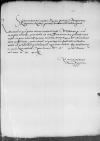List #2689
Sigismund I Jagiellon do Ioannes DANTISCUSWielowieś, 1543-11-27
| odebrano Heilsberg (Lidzbark Warmiński), 1543-12-15 Rękopiśmienne podstawy źródłowe:
| ||||
Tekst + aparat krytyczny + komentarzZwykły tekstTekst + komentarzTekst + aparat krytyczny
Reverendo in Christo Patri, domino
Reverende in Christo Pater, sincere nobis dilecte.
Mittimus Paternitati Vestrae exemplar litterarum, quas dedit ad nos
illustris dominus
Quae bene valeat.
Ex
Ad mandatum regiae maiestatis proprium


 BCz, 1601, p. 490
BCz, 1601, p. 490